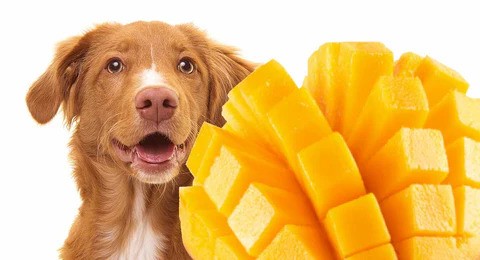Mangoes are one of the sweetest and juiciest fruits we enjoy, especially in the summer. If you’re a dog parent, chances are you’ve seen those curious puppy eyes staring at you while you bite into a mango slice.
Yes, dogs can eat mango in moderation. The juicy fruit is safe, tasty, and nutritious, making it a healthy occasional treat when served fresh, peeled, and without the seed.
In this guide, we’ll explain everything you need to know—from safety tips to serving ideas—so your dog stays happy and healthy.
Mango can be a healthy treat for dogs when given in small amounts. It’s loaded with vitamins like A, B6, C, and E, which support your dog’s immune system, skin, and eyesight. The natural fiber can also help digestion if introduced slowly.
Most dogs love the sweet, juicy taste, making it a fun reward during hot days. But because mango has natural sugars, it’s best kept as an occasional snack rather than a daily food.
Always peel the skin, remove the pit, and cut the fruit into small pieces before sharing it. If your dog is healthy and you serve it safely, mango can be a simple way to add variety and extra nutrients to their diet.

Yes, mangoes are safe for dogs as long as you prepare them correctly. The flesh of the fruit is soft, sweet, and easy for dogs to eat. It’s full of important nutrients that can boost health.
However, the pit and skin are not safe. The pit can cause choking or blockages, while the skin is hard to digest and may upset your dog’s stomach.
Always peel the mango and remove the seed before serving. Moderation is important too — too much mango can cause loose stools or weight gain because of the sugar content.
If your dog is otherwise healthy and you stick to small, safe portions, mango can be a safe and enjoyable treat.
- Rich in Vitamins – Packed with Vitamin A for eye health, Vitamin C for immunity, and Vitamin E for skin and coat.
- Fiber Support – Helps regulate digestion and keeps bowel movements healthy.
- Natural Antioxidants – Fights free radicals and supports long-term health.
- Low in Fat – A light, refreshing treat compared to many fatty snacks.
- Hydration Boost – High water content keeps your dog cool and hydrated.
- Mineral Source – Provides potassium and magnesium for muscle and nerve function.
Mango itself is not toxic, but it can become harmful if given in the wrong way or too often. The fruit is high in natural sugar, which may cause weight gain, dental problems, or worsen conditions like diabetes.
Eating too much at once can also upset your dog’s stomach and cause diarrhea. The pit is the most dangerous part, as it can choke your dog or cause a blockage if swallowed.
Even the skin is tough to digest and might lead to tummy troubles. That’s why it’s important to offer only the soft flesh in small amounts.
Used wisely, mango is safe, but overfeeding or giving unsafe parts can turn this sweet fruit into a problem.
Fresh mango is a better option than dried mango for dogs. Most store-bought dried mango has added sugar and preservatives, which can be harsh on your dog’s stomach and harmful for long-term health.
Even if you make dried mango at home, the drying process concentrates the natural sugar, meaning a smaller piece carries much more sweetness than fresh fruit.
This makes it easy to overfeed without realizing it. If you ever offer dried mango, keep the portion very tiny and make sure it has no extra ingredients.
But overall, fresh peeled mango pieces are the safer, healthier choice. Your dog gets the same flavor and nutrients without the added risks that come with dried fruit.

Dogs should never eat mango seeds, also called pits. The pit is large and slippery, making it a serious choking hazard.
If swallowed, it can also cause a dangerous blockage in your dog’s stomach or intestines, which might require emergency surgery.
On top of that, mango pits contain tiny amounts of cyanide, a natural toxin found in some fruit seeds.
While a single pit may not poison your dog, it’s still not safe to risk. Always cut the mango carefully, remove the pit completely, and only share the soft fruit flesh.
If your dog accidentally eats a pit, call your vet right away. Quick action can prevent serious health problems and keep your dog safe.
It’s best to avoid giving dogs mango skin. While not toxic, the skin is tough, fibrous, and hard to digest.
Eating it can cause stomach upset, vomiting, or even a blockage in smaller dogs. Some dogs may also react to a compound in mango skin that irritates the mouth or skin.
To keep things simple and safe, always peel the mango and only share the soft flesh in small, bite-sized pieces your dog can easily chew.
Dogs should not chew or eat parts of a mango tree. The bark, branches, and sap can be irritating to their mouth and digestive system.
Some dogs may develop drooling, stomach upset, or skin irritation if they come in contact with the sap.
Mango trees are not considered a safe chewing option. If your dog likes chewing on wood, offer safe alternatives like vet-approved chew toys or sticks designed for dogs. This avoids accidental poisoning or injuries.
No, mango leaves are not safe for dogs. They contain compounds that may upset your dog’s stomach and cause vomiting or diarrhea.
The leaves are also rough in texture, which makes them difficult to digest. While a small nibble may not always cause serious harm, it’s still better to avoid letting your dog chew or eat mango leaves.
If your pet shows interest in leaves, redirect them with safe chew toys or healthy dog-friendly treats instead.
Yes, dogs can eat pineapple in moderation. Fresh pineapple is full of vitamins like C and B6, plus healthy fiber that supports digestion.
Always remove the tough skin and hard core, as these parts are difficult to chew and may upset your dog’s stomach.
Offer only small, bite-sized chunks of the soft fruit as an occasional treat. Because pineapple is naturally sweet and acidic, too much can cause loose stools, so keep portions small and simple.

Mango ice cream is not recommended for dogs. Most ice cream contains dairy, added sugars, and sometimes artificial flavors that can upset your dog’s stomach or cause long-term health issues.
Some ice creams may even contain xylitol, which is toxic to dogs. Even if it’s “mango-flavored,” it’s not the same as fresh fruit.
If you want a safe, cool treat, freeze small mango cubes or blend mango with plain, unsweetened yogurt made specifically for pets.
Plain, unsweetened yogurt with fresh mango mixed in can be safe in small amounts, but flavored or store-bought mango yogurts usually aren’t a good idea.
Many brands add extra sugar, artificial flavors, or sweeteners like xylitol, which are harmful to dogs.
If your dog tolerates dairy, you can make a safe version at home by blending peeled mango with plain yogurt. Offer just a spoonful or two as an occasional treat to avoid stomach upset.
Mango should only be an occasional treat and must not replace regular dog food. In general, treats — including fruit — should make up no more than 10% of your dog’s daily diet. Here’s a safe portion guide:
- Extra-small dogs (2–20 lbs): 1–2 small pieces
- Small dogs (21–30 lbs): 2–3 small pieces
- Medium dogs (31–50 lbs): 5–6 small pieces
- Large dogs (51–90 lbs): A small handful of pieces
- Extra-large dogs (91+ lbs): A larger handful
If your dog eats too much mango, they may show signs like diarrhea, vomiting, or stomach discomfort. Always start with a small portion and monitor their reaction.
Serving mango the right way makes it both safe and enjoyable:
- Wash the fruit well to remove any dirt or chemicals.
- Peel off the skin, as it can be tough to digest.
- Remove the seed (pit) to prevent choking or blockage.
- Cut the soft flesh into small, bite-sized cubes.
Simple ways to serve mango:
- Offer raw cubes as a light snack.
- Mash and mix into your dog’s food.
- Freeze small chunks for a refreshing summer treat.
- Blend with dog-safe fruits like blueberries or bananas for a smoothie.
Always start with small portions and watch how your dog responds.
Some dogs may show allergic or sensitivity signs after eating mango (especially from the peel or sap exposure). Watch for:
- Skin irritation or itching (particularly around the mouth or paws).
- Facial swelling or hives (rare but possible).
- Vomiting or diarrhea after eating.
- Excessive drooling or pawing at the mouth.
If you see severe signs (trouble breathing, swelling of face or throat, collapse), get emergency vet help immediately. For mild GI upset, withhold food for 12–24 hours (water available) and call your vet.
Treats are a fun way to bond with your dog, but it’s important to keep them limited. Snacks like fruit, biscuits, or chews should make up no more than 10% of your dog’s daily diet.
Too many extras can lead to weight gain, picky eating, or stomach upset. Focus on balanced dog food for proper nutrition, and use treats for training or special moments. Keeping portions small helps your dog stay healthy, happy, and energized.
Call your veterinarian if:
- Your dog swallowed the pit or a large piece that could cause a blockage.
- Your dog shows severe vomiting, repeated diarrhea, lethargy, or signs of an allergic reaction (swelling, breathing trouble).
- You’re unsure what your dog ate or how much — better to call than to guess. Many vet offices and poison hotlines can give immediate advice.
- Peel it. ✔️
- Remove and discard the pit. ✔️
- Cut into appropriate, bite-sized pieces. ✔️
- Offer a small initial amount and watch for reactions. ✔️
- Avoid if dog is diabetic, obese, or has pancreatitis unless your vet okays it. ✔️
Most healthy dogs can safely eat mango in small amounts, but always remove the pit and peel before serving.
Mango has natural fiber that can loosen stools if fed too much, so moderation is important to prevent diarrhea.
A few small cubes occasionally are safe. Treats like mango should never exceed 10% of your dog’s daily diet.
Dogs with diabetes, obesity, or sensitive stomachs should avoid mango due to sugar content, which may worsen health conditions.
Yes, though rare. Some dogs may show itching, rashes, or stomach upset. Stop feeding and consult your vet immediately.
Dogs can safely enjoy apples, blueberries, watermelon, bananas, and strawberries. Always remove seeds, pits, or rinds before offering them.
Yes, kiwi is safe in small amounts. Peel the skin, cut into small pieces, and serve occasionally as treats.
Plain, air-popped popcorn is safe as an occasional snack. Avoid butter, salt, or seasonings, which can harm your dog.
Pickles aren’t recommended for dogs. They’re high in salt, spices, and vinegar, which may upset digestion and harm overall health.
Yes, cucumbers are safe, low-calorie treats. They help with hydration and make a crunchy, refreshing snack for your dog.
Mango is a safe, tasty treat for dogs when given in moderation. Always peel it, remove the pit, and serve small pieces. With the right preparation, this sweet fruit can be a refreshing and healthy snack your dog will love.
